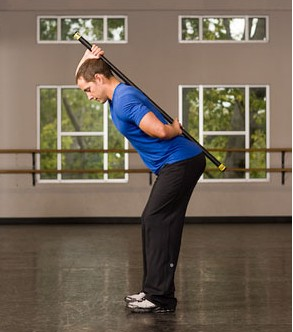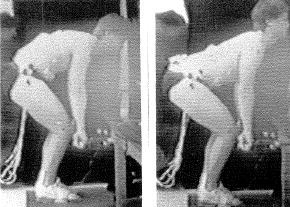by Art Horne
Last week we discussed the importance of bringing all professionals who care for and provide performance services to your student-athletes together to develop a consistent teaching methodology and progression to mastering the squat pattern. This week we look at the Hip Hinge.

Deadlift – Hip Hinge
Hip Hinge: all athletes should be able to separate their hips from a back strategy both in 2-legs and single leg stance -whether its knee, hip or other LE injury pain, we should be able to look at this movement pattern and address some overall concerns IN ADDITION to their traditional rehab program.
The hip hinge can be easily taught and standardized with our stick series.
Teaching Stick Series:
1. Stick maintains contact with three points (head, back and butt crack) throughout entire movement.
2. Reach butt backwards; knees should have slight bend.
3. Start with two feet on ground and progress to single leg stance.
4. This is not a squat pattern – be sure to hinge at the hips.
5. Maintain a packed neck (c-spine in-line with sternum throughout movement).
Start one foot away from wall (maybe just less) and reach back towards the wall with butt
1. Maintain three points of contact with stick on head, back and butt crack
2. This is not a squat pattern – first motion should be back towards the wall and not downwards.
3. Inch outwards from the wall with each successful repetition and repeat until you have found your end range.
4. ALTERNATIVE: face wall and touch with hands, move away from wall and repeat until you have reached max distance from wall while maintaining perfect form
Progression:
1. Two Leg Stick
2. SL Stick
3. 2-Leg – 2 hand Kettlebell Deadlift
4. SL 2-DB Deadlift
5. SL contralateral 1-DB Deadlift
When you finally get strength and sports medicine professionals together in the same room some amazing things begin to happen, especially when you start talking about hinging at the hips including:
1. Agreement to Pack the Neck: Packing the neck and maintaining a neutral cervical spine instead of admiring yourself in the mirror during a hip hinge stick series becomes a universal theme among both groups and taught and coached consistently – whether it’s pulling 300 pounds from the floor during a sumo squat or 4 weeks post ACL surgery during a simple stick series. Knowing where an athlete is going and where they’ve come from is half the battle in my opinion.
2. Glute activation takes on a whole new meaning to athletic trainers when they see firsthand the work and technical coaching that strength coaches employ with their athletes. Sets of 3x10 for glute bridges and then discharge to full participation is no longer acceptable.
3. Bad Hip Hinge means Bad Back: In the same breath, strength coaches are able to discuss challenges with low back pain patients with sports medicine professionals and appreciate how important they are in the rehabilitation and care of those persons as well as how incredibly dangerous a poorly performed lift can be.

Read article on Hip Hinge by clicking HERE.


